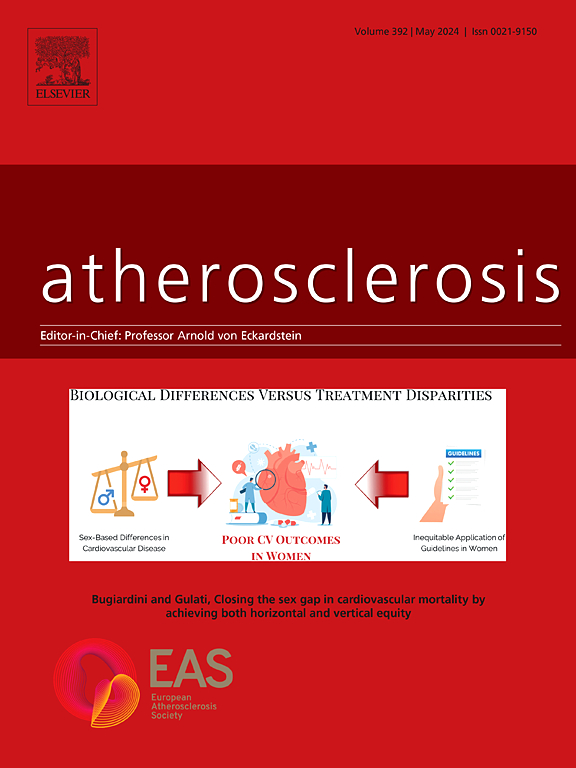世卫组织6个区域13个国家冠心病患者残留合并血脂异常和高甘油三酯血症的频率:INTERASPIRE的结果
IF 4.9
2区 医学
Q1 CARDIAC & CARDIOVASCULAR SYSTEMS
引用次数: 0
摘要
背景和目的高甘油三酯血症(HTG)与动脉粥样硬化事件的风险独立相关,即使在ldl -胆固醇水平得到控制的情况下也是如此。这项INTERASPIRE研究确定了来自世界卫生组织(WHO) 6个区域13个国家的冠心病(CHD)患者HTG和残余合并血脂异常的频率及其相关因素。方法对冠心病患者进行标准化的研究访谈和检查,包括对空腹血液样本进行集中分析。甘油三酯(TG)和低密度脂蛋白胆固醇升高分别定义为≥1.7 mmol/L和1.8 mmol/L。两者的升高被认为是合并血脂异常。结果共获得4069例患者的血脂谱。平均年龄为60.1岁(21.1%为女性,12.6%为吸烟者,24%为体重指数(BMI)肥胖,61%为高血压,44%为自述糖尿病)。受试者在冠心病住院1.05年(0.76-1.45年)后接受评估。总体而言,12.7%的患者不使用降脂疗法(LLT), 50.0%的患者使用高剂量他汀类药物,11.8%的患者使用联合治疗。使用特异性tg降低疗法的比例为2.3%。三分之一的患者有HTG, 24.6%的患者合并了血脂异常。HTG在所有国家都有发现,但TG的中位值各不相同,未使用LLT的国家TG值更高。HTG与女性性别、吸烟、BMI、血压和低密度脂蛋白胆固醇独立相关。HTG与高密度脂蛋白胆固醇呈负相关。结论shtg和残余合并血脂异常是常见的,但各国差异较大。更健康的生活方式、减轻体重、更多地使用联合治疗以及基于证据的降tg治疗对于降低HTG和合并血脂异常的风险是必要的。本文章由计算机程序翻译,如有差异,请以英文原文为准。
Frequency of residual combined dyslipidemia and hypertriglyceridemia in patients with coronary heart disease in 13 countries across 6 WHO Regions: Results from INTERASPIRE
Background and aims
Hypertriglyceridemia (HTG) is independently associated with risk of atherosclerotic events, even when LDL-cholesterol levels appear controlled. This INTERASPIRE study determined the frequency of HTG and residual combined dyslipidemia and their related factors in patients with coronary heart disease (CHD) from 13 countries across six World Health Organization (WHO) regions.
Methods
Participants with CHD underwent a standardized study interview and examination, including a centralized analysis of fasting blood samples. Elevated triglyceride (TG) and LDL-cholesterol were defined as ≥ 1.7 mmol/L and 1.8 mmol/L, respectively. Elevation in both was considered combined dyslipidemia.
Results
Lipid profiles were available for 4069 patients. The mean age was 60.1 years (21.1 % women, 12.6 % smokers, 24 % obesity by body mass index [BMI], 61 % hypertension, and 44 % self-reported diabetes). Participants were evaluated 1.05 (0.76–1.45) years after their index CHD hospitalization. Overall, 12.7 % used no lipid-lowering therapies (LLT), 50.0 % used high-dose statins, and 11.8 % used combination therapies. Specific TG-lowering therapies were used by 2.3 %. One-third of patients had HTG, and 24.6 % had combined dyslipidemia. HTG was seen in all countries, but median TG values varied, with higher values among those not using LLT. HTG was independently associated with female sex, smoking, BMI, blood pressure, and LDL-cholesterol. HTG was inversely associated with HDL-cholesterol.
Conclusions
HTG and residual combined dyslipidemia are common, although with wide variability between countries. A healthier lifestyle, weight reduction, greater use of combination therapy, and evidence-based TG-lowering treatments are necessary to reduce the risks of HTG and combined dyslipidemia.
求助全文
通过发布文献求助,成功后即可免费获取论文全文。
去求助
来源期刊

Atherosclerosis
医学-外周血管病
CiteScore
9.80
自引率
3.80%
发文量
1269
审稿时长
36 days
期刊介绍:
Atherosclerosis has an open access mirror journal Atherosclerosis: X, sharing the same aims and scope, editorial team, submission system and rigorous peer review.
Atherosclerosis brings together, from all sources, papers concerned with investigation on atherosclerosis, its risk factors and clinical manifestations. Atherosclerosis covers basic and translational, clinical and population research approaches to arterial and vascular biology and disease, as well as their risk factors including: disturbances of lipid and lipoprotein metabolism, diabetes and hypertension, thrombosis, and inflammation. The Editors are interested in original or review papers dealing with the pathogenesis, environmental, genetic and epigenetic basis, diagnosis or treatment of atherosclerosis and related diseases as well as their risk factors.
 求助内容:
求助内容: 应助结果提醒方式:
应助结果提醒方式:


